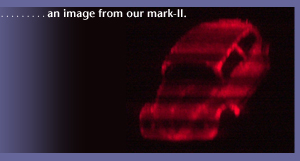
The Spatial Imaging group at the MIT Media Lab developed new technology and interfaces for holographic and other spatial displays. It was directed by Stephen Benton, who passed away November 9, 2003. Work on electronic capture and display of 3-D images has continued as a part of the work of the Media Lab's Object-Based Media group.
The holographic video project is developing a real-time imaging system that can render and display computer generated holograms at near-video rates. So far, we have demonstrated two prototype displays: the Mark-I and the Mark-II. The Mark-1 display is capable of rendering full color 25x25x25mm images with a 15 degree view zone at rates around 20 frames per second. The Mark-II display provides 150x75x150mm images with a 36 degree view zone at rates of around 2.5 frames per second. Our ongoing research examines methods to reduce computation time, ways to generate more realistic images, hologram compression and encoding schemes, new specialized hardware for optical modulation and computation, and new display architectures.

|
|
|||||||
|
|
DISPLAY ARCHITECTURE mark-I display overviewmark-II display overview mark-II optical pathways mark-II RF processing COMPUTATIONAL SUBSYSTEMS hologram
data formats DEMO & DISPLAY TOOLS see some example images!chex, sync, SCSI load, HIPPI load etc... COMPUTATIONAL METHODS computing
holographic stereograms FUTURE DISPLAY HARDWARE experiments with new modulators |
||||||
| |
|||||||
|
|
|||||||